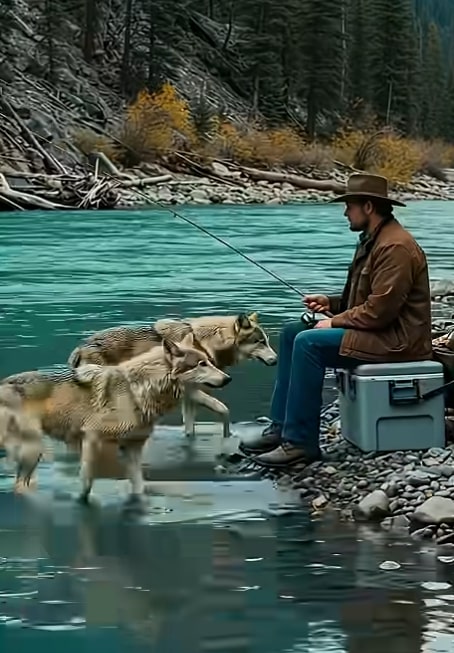The river looked like glass in motion—turquoise water curling around stones, spruce trees mirrored along the bank, and a thin mountain wind carrying the smell of rain. That calm was shattered by a sudden scraping sound and the frantic thrash of an animal near the shoreline. A young beaver, its slick coat matted with silt, had become tangled in a derelict fishing net that had washed up among the rocks. Every struggle pulled the cords tighter. Exhaustion set in. The beaver’s teeth gnawed at the twine, but the knots only bit deeper.

From across the channel, movement flashed gray against the timberline. A trio of gray wolves—curious, alert, and perfectly at home in the cold morning light—stepped into the shallows. Wolves are apex predators, but they are also social animals that read landscapes like we read faces. Ears forward, tails steady, they approached the commotion but did not charge. They circled once and paused, studying the beaver’s awkward, spiraling efforts as if deciding what the scene required: pursuit, avoidance, or something else entirely.
Downriver, a fisherman had been casting from the pebbled bank. He saw the tangle, the wolves, and the stakes. Instinct said to keep distance. Conscience said do not look away. With slow, deliberate steps, he waded toward the trapped beaver, keeping his hands visible and his shoulders relaxed. The wolves shifted, not with aggression but with a measured awareness that felt almost like a perimeter. Nothing in their body language threatened him; nothing suggested panic. They watched. He kept moving.
At arm’s length, the reality of the trap came into focus. The net had cinched around the beaver’s torso and forepaws, pinning one hind leg and dragging the tail. A tight ring of cord pressed into the fur at the neck. The fisherman spoke in a low voice to quiet his own adrenaline and to keep the animal from thrashing. He slid a pocketknife along the mesh, cutting small, controlled sections so the net wouldn’t snap back across the beaver’s face. A foot of wire gave way, then another. Breath steadied. The wolves eased closer to the waterline, heads tilted, eyes bright with concentration.
There was a moment when the beaver lay still, chest heaving, as if deciding whether to trust the strange silence. The fisherman used it. He slipped two fingers beneath the tightest strand and lifted gently to protect the skin, then sliced the final loop. The net slackened and fell like a shed skin. For a heartbeat, everything paused—the river, the wolves, the man—locked in a fragile balance between fear and relief.
The beaver came to life like a spring released. It pushed forward, stumbled, then turned back in a motion that looked—if not like gratitude, then like understanding—before slapping its tail and sliding into the blue current. The wolves didn’t give chase. Instead, they stepped aside and followed the ripples with their eyes, calm as sentries who had finished a shift. The fisherman sank to a knee, hands shaking with the rush of what almost happened and what, mercifully, did not.
Rescues like this are not fairy tales; they are the result of patience and choosing to de-escalate. The wolves could have asserted dominance. The man could have retreated. The beaver could have lost the strength to breathe. Instead, restraint won. On wild rivers, restraint is the difference between chaos and coexistence. It is also a reminder that not every encounter between species must end in conflict—sometimes the smartest participant is the one who decides to hold still and let a safer choice unfold.
For the fisherman, the rest of the day passed in a softer register. He broke down the net and packed it out with his gear, promising himself to return later with a trash bag for the rest of the debris along the bank. Derelict nets and lines—often called ghost gear—are silent hazards that trap fish, beavers, otters, waterfowl, and even pets long after the original owners have left. One hour with a blade and a bag can save a season’s worth of suffering. On this day, it saved a single life, and that was enough.
The wolves drifted back into the timber in a loose single file, their shoulders sliding like shadows against the spruce trunks. If they left a lesson, it was about boundaries. They didn’t adopt the beaver, and they didn’t befriend the man. They simply chose not to turn distress into opportunity. It is fashionable to call scenes like this “miracles,” but the truth is more grounded: wild animals make choices based on context, and humans can either inflame those choices or calm them. When calm leads, everyone goes home.
Conservationists point out that beavers are engineers of the watershed. Their dams store water, create wetlands, raise water tables, and build habitat for trout, songbirds, moose, and even the insects that fuel entire food chains. Save one beaver and you save a hundred side effects: slow water that resists drought, ponds that buffer wildfire, and marsh grass that filters runoff before it reaches the main stem of the river. To protect a beaver is to heal a valley—small work with big consequences.
What should you do if you find wildlife trapped in gear? Safety first. Keep people and pets back. Observe the animal’s breathing and movement. If the situation is risky—sharp wire, deep water, aggressive behavior—call local wildlife authorities or a rescue group and monitor from a distance. If it’s safe to act, use gloves and cut away material in tiny sections, never pulling tight against the skin. Avoid loud noises or quick advances. And always pack out every scrap of gear so the riverbank doesn’t trade one hazard for another.
When the fisherman finally headed home, the sky had shifted from the thin blue of morning to the deeper blue that carries the day toward evening. The river kept talking to the stones, unbothered. Somewhere upstream, the beaver found a quiet eddy to groom and warm itself. Downstream, three gray wolves paused in a meadow and lifted their noses into the wind. If you could translate their thoughts into words, they might sound like this: today, the valley did not waste its strength on fear.



